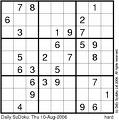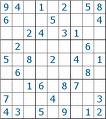Do U Know How To Play Sudoku ?
By cheenumaster
@cheenumaster (123)
Iceland
17 responses
@expect007 (360)
• India
3 Dec 06
yea i know it very well.....i play it usually.every day i will spend half an hour for it.......
@sweetpea_216 (1470)
• United States
2 Dec 06
I do! Here's a strategy I use: I actually to try and knock out certain numbers. If there are a lot of two's then I go around trying to see where they can go. Other than that, it's freelance problem solving. It's a process of elimination. I like it because it keeps me busy. Sometimes I hate it when I can't find a number. It's like I've been going in circles, but then I make progress, Yay for me! They can be fun when you finish.
@geevee (884)
• India
24 Nov 06
ya.....i know how to play.sudoku or su doku (sudo'ku)[Jap.,=single number], a number puzzle consisting, in its classic form, of a square divided into nine squares, with each smaller square divided into nine boxes, thus forming an overall grid of 81 boxes. To solve the puzzle, a single number (from 1 to 9) must be entered in each blank box so that each number is used only once in each smaller square and only once in each row and column in the larger square. A number of the boxes are always filled in by the maker of the puzzle, providing both clues and limitations to where the solver may place numbers, and the degree of difficulty of the puzzle is determined by which numbers the puzzle maker chooses to reveal as clues. Variations include the use of larger or smaller squares than the 9-box-by-9-box classic grid, irregular divisions of the overall grid, and additional restrictions on the placement of the numbers.
@swarn47 (1706)
• India
22 Nov 06
I dont know how to play this game.
Sudoku (?? sudoku?), also known as Number Place or Nanpure, is a logic-based placement puzzle. The aim of the puzzle is to enter the digits 1 through 9 in each cell of a 9×9 grid made up of 3×3 subgrids (called "regions") so that each row, column, and region contains exactly one instance of each digit. A set of clues, or "givens", constrain the puzzle such that there is only one way to correctly fill in the remainder.
Completed sudoku puzzles are a type of Latin square, with the additional constraint on the contents of individual regions. Leonhard Euler is sometimes cited as the source of the puzzle based on his work with Latin squares.
The modern puzzle Sudoku was invented in Indianapolis in 1979 by Howard Garns. Garns' puzzles appeared in Dell Magazines, which published them under the title "Number Place". Sudoku became popular in Japan in 1986, when puzzle publisher Nikoli discovered the game in older Dell publications. The puzzles became an international hit in 2005.
Solution methods
The strategy for solving a puzzle may be regarded as comprising a combination of three processes: scanning, marking up, and analyzing.
Scanning
Scanning is performed at the outset and throughout the solution. Scans need be performed only once in between analyses. Scanning consists of two techniques:
• Cross-hatching: the scanning of rows to identify which line in a region may contain a certain numeral by a process of elimination. The process is repeated with the columns. For fastest results, the numerals are scanned in order of their frequency, from high to low. It is important to perform this process systematically, checking all of the digits 1–9.
• Counting 1–9 in regions, rows, and columns to identify missing numerals. Counting based upon the last numeral discovered may speed up the search. It also can be the case, particularly in tougher puzzles, that the best way to ascertain the value of a cell is to count in reverse—that is, by scanning the cell's region, row, and column for values it cannot be, in order to see what remains.
Advanced solvers look for "contingencies" while scanning, narrowing a numeral's location within a row, column, or region to two or three cells. When those cells lie within the same row and region, they can be used for elimination during cross-hatching and counting. Puzzles solved by scanning alone without requiring the detection of contingencies are classified as "easy;" more difficult puzzles cannot be solved by basic scanning alone.
Scanning stops when no further numerals can be discovered, making it necessary to engage in logical analysis. One method to guide the analysis is to mark candidate numerals in the blank cells. There are two popular notations: subscripts and dots.
• In the subscript notation the candidate numerals are written in subscript in the cells. However, original puzzles printed in a newspaper usually are too small to accommodate more than a few digits of normal handwriting. Thus, solvers often create a larger copy of the puzzle.
• The second notation uses a pattern of dots in each square, where the dot position indicates a number from 1 to 9. The dot notation can be used on the original puzzle. Dexterity is required in placing the dots, since misplaced dots or inadvertent marks inevitably lead to confusion and may not be easily erased.
An alternative technique is to "mark up" the numerals that a cell cannot be. A cell will start empty and as more constraints become known, it will slowly fill until only one mark is missing. Assuming no mistakes are made and the marks can be overwritten with the value of a cell, there is no longer a need for any erasures.
The two main approaches to analysis are "candidate elimination" and "what-if". In "candidate elimination", progress is made by successively eliminating candidate numerals from cells to leave one choice. After each answer has been achieved, another scan may be performed—usually checking to see the effect of the contingencies. One method works by identifying "matched cells". If precisely two cells within a scope (a particular row, column, or region) contain the same two candidate numerals (p,q), or if precisely three cells within a scope contain the same three candidate numerals (p,q,r), these cells are said to be matched. The placement of these numerals anywhere else within that same scope would make a solution impossible; thus, the candidate numerals (p,q,r) scope can be deleted. When all else fails, ask the question, 'Would entering the eliminated numeral prevent completion of the other necessary placements?' If the answer to the question is 'Yes,' then the candidate numeral in question can be eliminated.
In the "what-if" approach (also called "guess-and-check", "bifurcation", "backtracking" and "Ariadne's thread"), a cell with two candidate numerals is selected, and a guess is made. The steps are repeated unless a duplication is found or a cell is left without a possible candidate, in which case the alternative candidate must be the solution. For each cell's candidate, the question is posed: 'will entering a particular numeral prevent completion of the other placements of that numeral?' If the answer is 'yes', then that candidate can be eliminated. The what-if approach requires a pencil and eraser or a good layout memory
Source: http://www.answers.com/sudoku?initiator=IE7:SearchBox

















